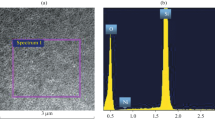Abstract
The structural characteristics (structural resistance coefficient, volume porosity, tortuosity coefficient, average pore radius, specific surface area) and specific electrical conductivity of high-silica micro- and macroporous glasses with different compositions (basic magnetite-free and magnetite-containing glasses) have been studied in solutions of sodium, lanthanum, and iron(III) chlorides at a constant ionic strength. It has been found that the differences in the morphology of the pore space and characteristics of secondary silica are the reasons for different intensities of variations in the structural parameters of microporous glasses upon their long-term contact with electrolyte solutions, with the most pronounced time variations occurring in lanthanum chloride solutions. In indifferent electrolyte solutions, glass composition has no effect on the value of the efficiency coefficient. For microporous glasses in solutions containing specifically adsorbabable ions, the value of the efficiency coefficient is mainly affected by the structure of secondary silica in pore space, other conditions being equal. It has been revealed that, in iron chloride solutions, the specificity of the counterions is more pronounced for the basic porous glasses.
















Similar content being viewed by others
REFERENCES
Mazurin, O.V., Roskova, G.P., Aver’yanov, V.I., and Antropova, T.V., Dvukhfaznye stekla: struktura, svoistva, primenenie (Two-Phase Glasses: Structure, Properties, Application), Leningrad: Nauka, 1991.
Enke, D., Janowski, F., and Schwieger, W., J. Micropor. Mesopor. Mater., 2003, vol. 60, p. 19.
Antropova, T.V., Doctoral (Chem.) Dissertation, St. Petersburg: Inst. of Silicate Chemistry, Russ. Acad. Sci., 2005.
De Jong, J., Lammertink, R.G.H., and Wessling, M., Lab on a Chip, 2006, vol. 6, p. 1125.
Yairi, M. and Richter, C., Sens. Actuators A, Phys., 2007, vol. 137, p. 350.
Zhang, C., Xing, D., and Li, Y., Biotechnol. Adv., 2007, vol. 6, p. 483.
Evstrapov, A.A., Esikova, N.A., Rudnitskaja, G.E., and Antropova, T.V., Opt. Appl., 2008, vol. 38, p. 31.
He, F., Liao, Y., Lin, J., Song, J., et al., Sensors, 2014, vol. 14, p. 19402.
Zakoldaev, R.A., Sergeev, M.M., Sivers, A.N., et al., Phys. Chem. Glass, 2018, vol. 44, p. 486.
Andreeva, Y.M., Sergeev, M.M., Zakoldaev, R.A., et al., J. Laser Micro Nanoeng., 2018, vol. 13, p. 193.
Veiko, V.P., Zakoldaev, R.A., Sergeev, M.M., et al., Opt. Express, 2018, vol. 26, p. 28 152.
Cheong, S.-W. and Mostovoy, M., Nat. Mater., 2007, vol. 6, p. 13.
Hua, M., Zhang, S., Pan, B., et al., J. Hazard. Mater., 2012, vol. P, p. 317.
Pshenko, O.A., Drozdova, I.A., Polyakova, I.G., et al., Phys. Chem. Glass, 2014, vol. 40, p. 167.
Rybak, A. and Kaszuwara, W., J. Alloys Compd., 2015, vol. 648, p. 205.
Cizman, A., Rogacki, K., Rysiakiewicz-Pasek, E., et al., J. Alloys Compd., 2015, vol. 649, p. 447.
Podoynitsyn, S.N., Sorokina, O.N., and Kovarski, A.L., J. Magn. Magn. Mater., 2016, vol. 397, p. 51.
Volkova, A.V., Ermakova, L.E., Kashpurina, E.A., et al., Phys. Chem. Glass, 2016, vol. 42, p. 322.
Ermakova, L.E., Grinkevich, E.A., Volkova, A.V., and Antropova, T.V., Colloid J., 2018, vol. 80, p. 492.
Ermakova, L.E., Grinkevich, E.A., Volkova, A.V., et al., Colloid J., 2019, vol. 81, p. 235.
Ermakova, L.E., Volkova, A.V., Antropova, T.V., and Murtuzalieva, F.G., Colloid J., 2014, vol. 76, p. 546.
Ermakova, L.E., Volkova, A.V., Antropova, T.V., and Zhukov, A.N., Colloid J., 2015, vol. 77, p. 283.
Ermakova, L.E., Kuznetsova, A.S., Volkova, A.V., and Antropova, T.V., Colloids Surf. A, 2019, vol. 576, p. 91.
Ermakova, L.E., Volkova, A.V., Kuznetsova, A.S., et al., Colloid J., 2018, vol. 80, p. 255.
Ermakova, L.E., Antropova, T.V., Volkova, A.V., et al., Glass Phys. Chem., 2018, vol. 44, p. 269.
Zhdanov, S.P., Wiss. Z. Friedrich-Schiller-Univ. Jena, Math.-Naturwiss. Reihe, 1987, vol. 36, p. 817.
Antropova, T.V., Kalinina, S.V., Kostyreva, T.G., et al., Glass Phys. Chem., 2015, vol. 41, p. 14.
Kuznetsova, A.S., Volkova, A.V., Ermakova, L.E., and Antropova, T.V., Glass Phys. Chem., 2018, vol. 44, p. 41.
Ermakova, L.E., Volkova, A.V., Faraonova, V.V., and Antropova, T.V., Colloid J., 2015, vol. 77, p. 715.
Erdey-Grúz, T., Transport Phenomena in Aqueous Solutions, Budapest: Akadémiai Kiadó, 1974.
Ermakova, L.E., Zhura, N.A., and Sidorova, M.P., Kolloidn. Zh., 1993, vol. 55, p. 62.
Volkova, A.V., Ermakova, L.E., Antropova, T.V., and Sidorova, M.P., Colloid J., 2010, vol. 72, p. 6.
Lur'e, Yu.Yu., Spravochnik po analiticheskoi khimii (Handbook on Analytical Chemistry), Moscow: Khimiya, 1989.
ACKNOWLEDGMENTS
The study was performed using the equipment of the Research Park of St. Petersburg State University (Interdisciplinary Resource Center for Nanotechnology, the Cryogenic Department). We are grateful to researchers at the Grebenshchikov Institute of Silicate Chemistry, Russian Academy of Sciences, T.G. Kostyreva, L.F. Dikaya, L.N. Kurilenko, and E.A. Semenova for implementation of the chemical analysis of the glasses.
Funding
This work was supported by the Russian Foundation for Basic Research, project no. 17-03-01011а. The samples of two-phase and porous glasses were prepared at the Grebenshchikov Institute of Silicate Chemistry, Russian Academy of Sciences, within the framework of state order no. 0097-2019-0015.
Author information
Authors and Affiliations
Corresponding author
Ethics declarations
The authors declare that they have no conflict of in-terest.
Additional information
Translated by A. Kirilin
Rights and permissions
About this article
Cite this article
Ermakova, L.E., Kuznetsova, A.S., Antropova, T.V. et al. Structural Characteristics and Electrical Conductivity of Porous Glasses with Different Compositions in Solutions of Sodium, Lanthanum and Iron(III) Chlorides. Colloid J 82, 262–274 (2020). https://doi.org/10.1134/S1061933X20030035
Received:
Revised:
Accepted:
Published:
Issue Date:
DOI: https://doi.org/10.1134/S1061933X20030035



